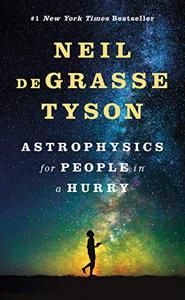
Want to learn the ideas in Astrophysics For People In A Hurry better than ever? Read the world’s #1 book summary of Astrophysics For People In A Hurry by Neil deGrasse Tyson here.
Read a brief 1-Page Summary or watch video summaries curated by our expert team. Note: this book guide is not affiliated with or endorsed by the publisher or author, and we always encourage you to purchase and read the full book.
Video Summaries of Astrophysics For People In A Hurry
We’ve scoured the Internet for the very best videos on Astrophysics For People In A Hurry, from high-quality videos summaries to interviews or commentary by Neil deGrasse Tyson.
1-Page Summary of Astrophysics For People In A Hurry
Cosmic Wonder, Cosmic Origins
Neil deGrasse Tyson explains that the universe began about 14 billion years ago. At this time, everything in the universe was smaller than a dot on paper and extremely hot. The forces governing it were unified (the same). Then came the big bang, which is when these forces differentiated into what we know today – gravity, electromagnetic force and strong nuclear force. Matter coalesced into a wide range of subatomic particles – electrons, neutrinos and quarks.
After the big bang, the universe cooled and expanded. Quarks formed into hadrons, which led to neutrons and protons. The early activity featured a crucial asymmetry: there was more matter than antimatter. If this weren’t true, then all of the matter would have been annihilated by its corresponding antiparticle in a blaze of light. When the universe was roughly one second old, it had cooled to a billion degrees Fahrenheit (roughly 1 million degrees Celsius).
Most of the particles that existed in the early universe were annihilated with their antimatter opposites. As it continued to cool, only one electron was left for every proton. At roughly two minutes into its existence, simple elements such as hydrogen and helium came about. These are still the most abundant elements in our universe today.
The universe started out with a hot, dense state. After that, it cooled down to 3000 kelvins (4940.33°F or 2726.9°C). At this temperature, the protons were slow enough for electrons to get captured by them and form atoms. The universe stayed in this state for billions of years before the stars formed and exploded into space, spreading heavy elements like carbon everywhere—which is essential for life on Earth as we know it today.
Newton’s Universal Laws
Neil deGrasse Tyson says that when Isaac Newton explained gravity, he changed how people think about the universe. Before that, people thought of Earth and the heavens as separate entities. But Newton showed them that they operated under the same laws, so there was no reason why celestial activity couldn’t be understood by humans on earth.
Tyson explains that the principle of universality is central to science. It led to other discoveries, such as helium being discovered even before it was found on Earth. Analysis of the sun’s spectrum also revealed helium, which comes from the Greek word for sun. Since these laws are in effect everywhere in space and time, humanity may encounter alien races someday. Regardless of their culture or behavior, they will be based on these same principles.
Science also depends on universal laws. One of them is the law of gravity, which allows scientists to determine facts about distant objects. Another universal law is the speed of light, which allows scientists to analyze things that are far away from us and understand their behavior. However, even though there are many universal laws in science, they can be difficult to figure out because they interact with each other and create specific phenomena.
Gravity, Dark Matter and Dark Energy
Proving his genius again, Tyson explains how Newton figured out the attributes of matter that make objects gravitate toward each other. He described this “force” between objects with a relatively simple equation that scientists have used for centuries. Einstein later showed it’s more accurate to think of gravity as working like a “warp in the fabric of space-time.” But he also demonstrated how mass bends light and proved Newton’s model theory didn’t work all the time.
Astrophysicists have observed massive objects in the universe that are moving faster than they should. They can’t explain this motion using all of the matter and energy that we know about, so there must be some additional mass out there that we can’t detect. Scientists don’t think this missing mass is contained in black holes because it would lead to other effects we could observe more directly. We call this invisible matter dark matter, but scientists don’t know what it is or how much of it exists in the universe.






